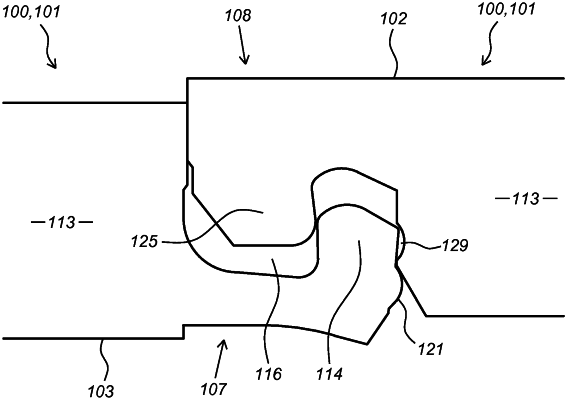| CPC E04F 15/02038 (2013.01) [E04F 13/0894 (2013.01); E04F 2201/0146 (2013.01); E04F 2201/023 (2013.01); E04F 2201/042 (2013.01); E04F 2201/043 (2013.01)] | 23 Claims |

|
1. A panel, in particular a floor panel, ceiling panel, or wall panel, comprising:
a centrally located core provided with an upper side and a lower side, which core defines a plane;
at least one first coupling part and at least one second coupling part connected respectively to opposite edges of the core,
which first coupling part comprises:
an upward tongue,
at least one upward flank lying at a distance from the upward tongue, and
an upward groove formed in between the upward tongue and the upward flank wherein the upward groove is adapted to receive at least a part of a downward tongue of a second coupling part of an adjacent panel,
at least one first locking element, provided at a distant side of the upward tongue facing away from the upward flank;
wherein at least a part of a proximal side of the upward tongue, facing the upward flank, is upwardly inclined towards the upward flank,
which second coupling part comprises:
a downward tongue,
at least one downward flank lying at a distance from the downward tongue, and
a downward groove formed in between the downward tongue and the downward flank, wherein the downward groove is adapted to receive at least a part of an upward tongue of a first coupling part of an adjacent panel;
at least one second locking element adapted for co-action with a first locking element of an adjacent panel, said second locking element being provided at the downward flank
wherein at least a part of a proximal side of the downward tongue, facing the upward flank, is downwardly inclined towards the downward flank,
wherein the first coupling part and the second coupling part are configured such that in coupled condition a pretension is existing, which forces the respective panels at the respective edges towards each other, wherein this is performed by applying overlapping contours of the downward tongue and the upward groove and overlapping contours of the upward tongue and the downward groove, and wherein the first coupling part and the second coupling part are configured such that the two of such panels can be coupled to each other by means of a fold-down movement and/or a vertical movement, such that, in coupled condition, wherein, in coupled condition, at least a part of the downward tongue of the second coupling part is inserted in the upward groove of the first coupling part, such that the downward tongue is clamped by the first coupling part and/or the upward tongue is clamped by the second coupling part, and wherein the upward tongue is oversized with respect to the downward groove; wherein the width of the upward tongue is oversized with respect to the width of the downward groove; wherein the maximum width of the upward tongue exceeds the maximum width of the downward groove; wherein the first locking element comprises a bulge, and wherein the second locking element comprises a recess,
wherein a part of a side of the downward tongue facing away from the downward flank is provided with a third locking element, in the form of an outward bulge, adapted for co-action with a fourth locking element, in the form of a recess, of an adjacent panel; and wherein at least a part of the upward flank is provided with a fourth locking element, in the form of a recess, adapted for co-action with the third locking element, in the form of an outward bulge, of an adjacent panel, and
wherein in a coupled state of adjacent panels, the upward tongue and the downward flank are in contact at mating surfaces immediately adjacent and below the coupled first locking element and the second locking element.
|